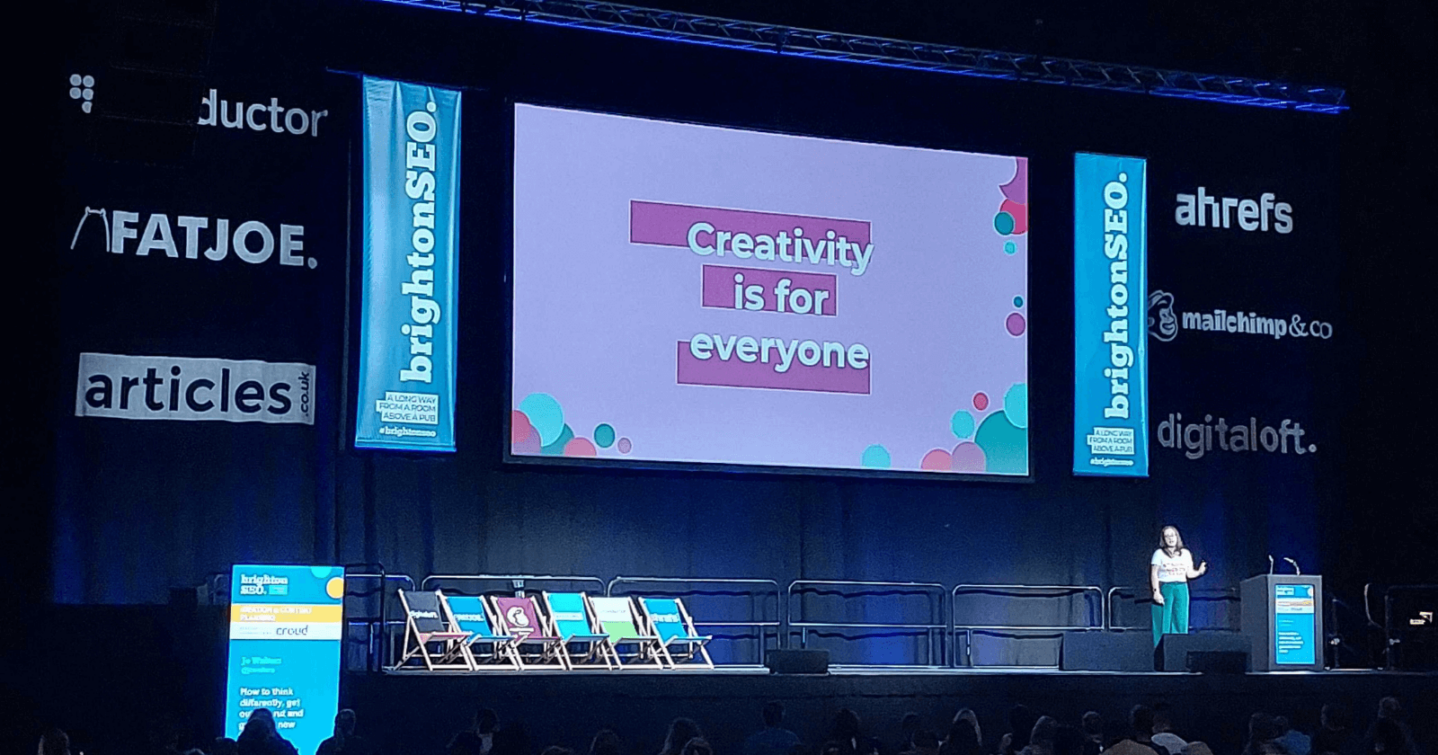Our SEO & Content team has returned from the seaside following a day at BrightonSEO! After two days of listening to talks from digital marketers from all over the world, they’re ready to start implementing their new ideas and strategies for our clients.
But what exactly did they learn from the popular SEO conference? And can you implement their learnings to your own digital marketing strategy?
1. 97% of website pages have accessibility errors
As SEO’ers, one of our priorities is to ensure users have a smooth experience when exploring a website. But when making changes and tweaking pages to provide just that, are we thinking about those with accessibility issues?
According to Miracle Inameti-Archibong and Beth Barnham’s talks, it appears not. We learnt that 97% of website pages have accessibility errors, making it harder for some users to navigate what are meant to be user-friendly websites.
For example, only 1% of sites use Schema, a form of structured data that makes it easier for search engines to understand a webpage and enhance its listing in search results. Schema helps provide context for your products and services, something that can create clearer, more visible results for users.
If your site is spotted with numerous accessibility issues, then you’re ignoring a large number of people with your marketing efforts. In fact, 15% of the world’s population has a disability, so it’s important to be inclusive when optimising a website for SEO. And, you should also remember that visual impairments are not the disabilities affected by poor site design and optimisations.
Key takeaways:
- Use a screen reader to see how a website may look to anyone that is visually impaired, but also know that there are other accessibility issues out there.
- Make sure headings are nested and sequential. Ensure that your content has a clear structure and is easy to follow, as opposed to using header tags in a random order, e.g. H1, then H3, then H2 and H3.
- Skip links can also be used, so that users can skip certain sections in your nav using a screen reader.
You can find the slides for this section here:
Beth Barnham – Accessibility, strategy and schema – do they go hand in hand?
Miracle Inameti-Archibong – Creating An Inclusive Web
2. Manual SERP analysis is an essential part of content writing – don’t just rely on AI
Creating content can be time consuming, hence why AI tools are becoming popular in the digital marketing industry. But these tools can only get you so far, and it’s important to not rely on them to do all the work for you.
In Chima Mmeje’s excellent talk, On-page optimization lessons from analyzing over 400 blog posts, she emphasised the importance of manual analysis of search engine results pages (SERPs) when doing your keyword research. It’s all well and good spending time finding search terms and importing them into an SEO tool, but to be able to rank well for those terms, you need to fully understand what’s already ranking and why.
It’s important to conduct manual SERP analysis in your research process so you get a better understanding of the terms you’re trying to include, how users and search engines see these terms, and which competitor has the most authority in this topic. Chima used the financial industry as an example, stating that Investopedia ranks for the majority of keywords as they’re an authoritative site – especially in Google’s eyes.
You can also identify other search opportunities this way – are there any featured snippets you can target? A People Also Ask? If Google lists more videos than pages and blogs for the term, can you repurpose your copy into a video to rank in that sense, too?
Key takeaways:
- Don’t rush your content research and spend time understanding the search landscape for the topic you’re writing about. Study the SERPs to see what sort of content is best suited for different search terms and what you can do to make your website stand out.
- Watch out for competitors that rank well and Google clearly sees as an authoritative source. Why are they ranking for multiple terms? How much of an expert are they within your topic cluster? Are there other search terms you can target with similar volume that you can target instead? Or can you create a video or another content type that Google may prefer?
3. We’ve always used heads to do SEO – now the future is headless
A ‘headless’ CMS is a type of content management system that can provide more flexibility than traditional CMSs, such as Wordpress. A headless CMS refers to the front-end of a website, i.e. the ‘head’, is separated from the back-end, the ‘body’. This essentially means that you can create and deploy content in any format you choose, rather than your page elements be automatically formatted to fit a CMS template.
A headless CMS is a good option when:
- Your project will be limited by the front-end restrictions of a traditional CMS
- You’re looking to create a unique user experience
- You want to use JavaScript frameworks
During his BrightonSEO talk, Start by looking at your “head”: jamstack SEO, Michael Boosalis spoke about the benefits of a headless CMS and Jamstack, a term that describes a modern web development architecture based on JavaScript, APIs, and Markup (JAM). Using these as a basis for your website can enhance overall web performance in a variety of ways – but only if it aligns with your site goals.
Key takeaways:
- Headless CMS is ideal for large websites, but for smaller ones it might not be needed.
- Headless CMS could be applied for CMS like Shopify and Wordpress (and it’s more secure, faster and easier to scale).
- Jamstack is not a code-free tool for building websites, and still requires coding skills and using APIs.
4. Avoid generic, common brand values in your copywriting
When considering your brand voice, many brands tend to choose values rather than personality traits, This can lead to using common values that are generic and already used by lots of businesses, such as:
- Professional
- Honest
- High-quality
- Reliable
- People-centred
Bethany Joy gave a fantastic talk on the immutable laws of brand voice, sharing her top nine tips and beliefs that businesses should remember. There was one particular tip that stood out: if a trait you’re thinking of using is something that no company would want to be the opposite of, then don’t use it.
Take ‘reliable’ for example – would anyone want to be seen as unreliable? Reliability is to be expected for all businesses, and so using it as one of your values or traits isn’t going to make your brand stand out.
Key takeaways:
- Go for brand attributes that are neither good nor bad, such as ‘brazen’ or ‘relentlessly curious’. Not every business is going to be bold, witty or sophisticated, and that’s OK. This is what makes brands stand out from one another, and by sticking with traits that are true to your business and actually represent who you are, the right customers will gravitate towards you.
- Remember, values and personality traits are two different things!
You can find Bethany’s slides on ‘The nine immutable laws of brand voice’ here.
5. Integrating SEO & Biddable
Becky Simms delivered a fantastic talk around better integrating SEO and paid activity to maximise results. She made a very good point that a customer doesn’t care what channel they found you on – just that they found you at the right time in the right place.
By applying psychology and behavioural science models, Becky highlighted the need to understand your audiences’ motivations – something beyond their demographics. She then explained the important role that organic search and content had to play throughout the funnel to tap into these more emotional needs. Her insights were all backed up by real world data, drawing on a report.
Becky’s insights were all bought together with a compelling image of a customer being like a baton in a relay race. Essentially as a digital marketer, we want to pick them up first and hold onto them throughout the whole race, making sure they stay in your client’s lane.
Key takeaways:
- Map a user’s buying journey and carefully consider where SEO and Paid have a role to play throughout the funnel. It often means working with different marketing teams more intelligently, and that’s something we practise at Loom.
You can find Becky’s talk, Your customer does not care what channel you use: how to integrate SEO and Paid, here.
SEO and Content services from Loom Digital
For us, staying up to date with the latest trends and updates from the digital marketing world is a priority. BrightonSEO is one of the many opportunities we have to learn more about the industry, meet other SEOs and content creators, and find inspiration.
If you’d like to know more about our SEO and content services and see how we can implement our learnings on your website, then speak to our team on 0117 923 2021 or send us an email at: [email protected].
This wasn’t Loom’s first time at BrightonSEO – read about our previous experience here.





